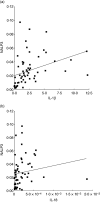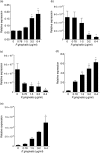Expression and regulation of the NALP3 inflammasome complex in periodontal diseases
- PMID: 19664151
- PMCID: PMC2745037
- DOI: 10.1111/j.1365-2249.2009.03972.x
Expression and regulation of the NALP3 inflammasome complex in periodontal diseases
Abstract
Periodontitis is an infectious process characterized by inflammation affecting the supporting structures of the teeth. Porphyromonas gingivalis is a major oral bacterial species implicated in the pathogenesis of periodontitis. Processing of interleukin (IL)-1 family cytokines is regulated by an intracellular innate immune response system, known as the NALP3 [nacht domain-, leucine-rich repeat-, and pyrin domain (PYD)-containing protein 3] inflammasome complex. The aim of the present study was to investigate by quantitative real-time polymerase chain reaction (PCR) the mRNA expression of NALP3, its effector molecule apoptosis associated speck-like protein (ASC), its putative antagonist NLRP2 (NLR family, PYD-containing protein 2), IL-1beta and IL-18 (i) in gingival tissues from patients with gingivitis (n = 10), chronic periodontitis (n = 18), generalized aggressive periodontitis (n = 20), as well as in healthy subjects (n = 20), (ii) in vitro in a human monocytic cell line (Mono-Mac-6), in response to P. gingivalis challenge for 6 h. The clinical data indicate that NALP3 and NLRP2, but not ASC, are expressed at significantly higher levels in the three forms of inflammatory periodontal disease compared to health. Furthermore, a positive correlation was revealed between NALP3 and IL-1beta or IL-18 expression levels in these tissues. The in vitro data demonstrate that P. gingivalis deregulates the NALP3 inflammasome complex in Mono-Mac-6 cells by enhancing NALP3 and down-regulating NLRP2 and ASC expression. In conclusion, this study reveals a role for the NALP3 inflammasome complex in inflammatory periodontal disease, and provides a mechanistic insight to the host immune responses involved in the pathogenesis of the disease by demonstrating the modulation of this cytokine-signalling pathway by bacterial challenge.
Figures



References
-
- Armitage GC. Periodontal diagnoses and classification of periodontal diseases. Periodontol 2000. 2004;34:9–21. - PubMed
-
- Gemmell E, Marshall RI, Seymour GJ. Cytokines and prostaglandins in immune homeostasis and tissue destruction in periodontal disease. Periodontol 2000. 1997;14:112–43. - PubMed
-
- Taylor JJ, Preshaw PM, Donaldson PT. Cytokine gene polymorphism and immunoregulation in periodontal disease. Periodontol 2000. 2004;35:158–82. - PubMed
-
- Landi L, Amar S, Polins AS, Van Dyke TE. Host mechanisms in the pathogenesis of periodontal disease. Curr Opin Periodontol. 1997;4:3–10. - PubMed
Publication types
MeSH terms
Substances
Grants and funding
LinkOut - more resources
Full Text Sources
Miscellaneous

